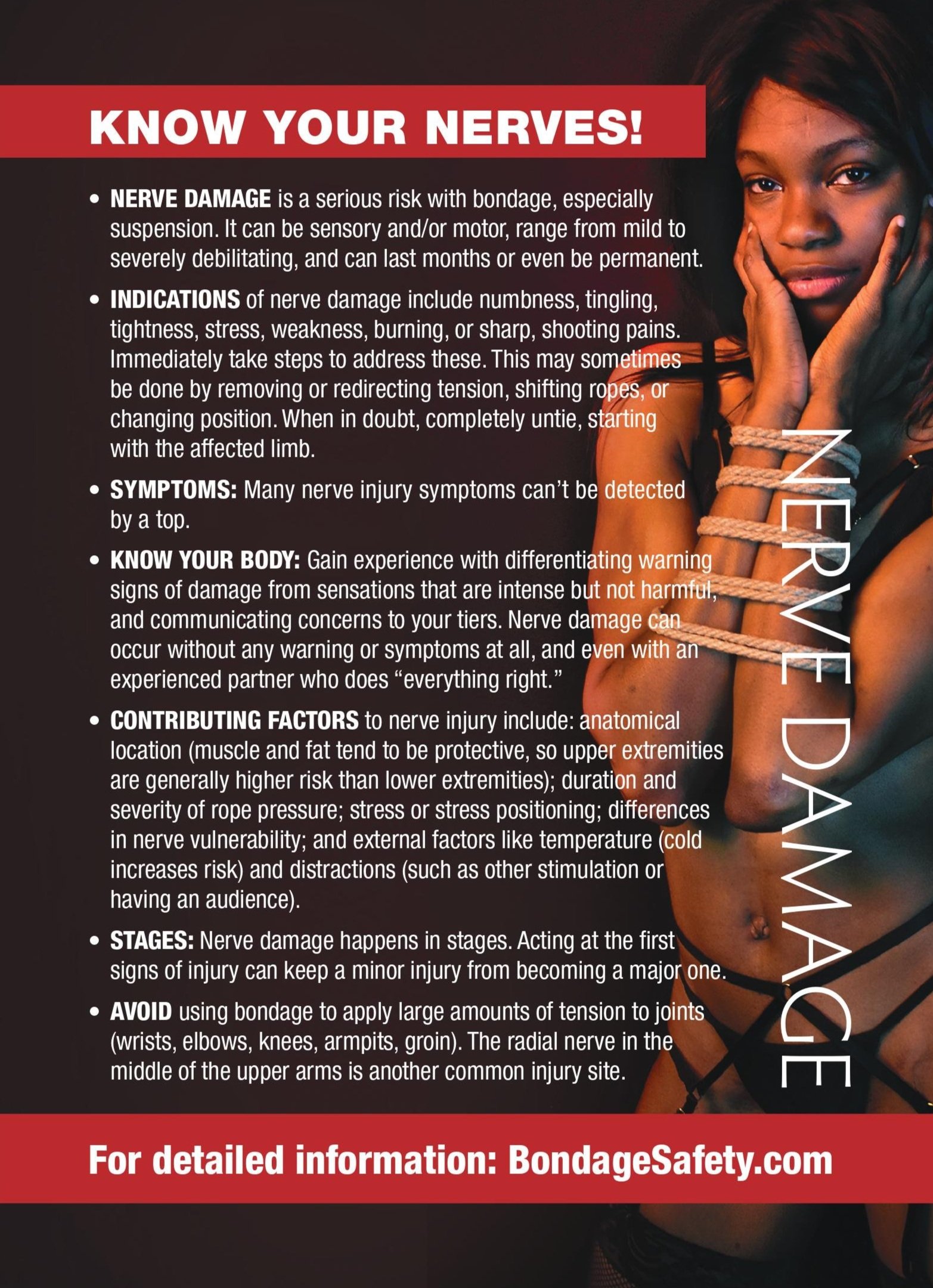Bondage Safety Flyer & Introduction
These pages are devoted to bondage safety and risk awareness-based education for new, experienced, and aspiring rope tops and bottoms. Safety basics apply to everything from bedroom bondage to suspension, shibari, and kinbaku to Western style. Articles range from very beginner (perfect if your bondage skills begin and end with tying your shoes) to advanced (including busting some extremely common myths about bondage safety).
Bondage Safety Flyer text
Bondage can be sexy and fun, but it can also be dangerous. This card contains some fundamental aspects of risk-aware consent. It is intended as a quick reference and a supplement to classes and other bondage education.
Bondage tips for tops & bottoms:
COMMUNICATE! Clear communication before, during, and after a rope scene will impress (and excite) an experienced, caring partner.
VET YOUR PARTNER(S) AND NEGOTIATE BEFORE PLAY: Discuss safewords/signals, expectations, rope marks, types of touch, risk awareness, limits, wants/needs, goal feelings, styles of play, and so on.
DISCLOSE YOUR HEALTH HISTORY. Especially diabetes, asthma, joint issues, phobias or triggers, seizures, nerve damage, and medications.
BE COMPLETELY SOBER while playing with rope.
MONITOR for ongoing consent and check in often. Check-ins can be experienced as reassuring and arousing.
BONDAGE CLASSES: Learn about safety and technique before playing with rope in a scene or the bedroom.
SAFETY SHEARS: Keep them close by, and practice using them.
FAINTING OR FALLING can cause serious injury; bondage should be adjusted to minimize risk. Causes of falls include furniture tipping over, hardpoints failing, rope breaks (more likely with natural fiber uplines), walking with bound arms, etc.
GAGS: Always have a safe signal. Be cautious about combining gags with bondage.
AVOID attaching bondage around the neck or from the genitals to an external point.
BEFORE PLAYING: Ensure that bathroom and hydration needs are addressed. Consider warming up before intense play.
MONITOR. Don’t leave someone alone in bondage.
Know your nerves:
NERVE DAMAGE is a serious risk with bondage, especially suspension. It can be sensory and/or motor, range from mild to severely debilitating, and can last months or even be permanent.
INDICATIONS of nerve damage include numbness, tingling, tightness, stress, weakness, burning, or sharp, shooting pains. Immediately take steps to address these. This may sometimes be done by removing or redirecting tension, shifting ropes, or changing position. When in doubt, untie entirely, starting with the affected limb.
SYMPTOMS: A top can’t detect many nerve injury symptoms.
KNOW YOUR BODY: Gain experience with differentiating warning signs of damage from intense but not harmful sensations and communicate concerns to your tiers. Nerve damage can occur without warning or symptoms and even with an experienced partner who does “everything right.”
CONTRIBUTING FACTORS to nerve injury include anatomical location (muscle and fat tend to be protective, so upper extremities are generally higher risk than lower extremities); duration and severity of rope pressure; stress or stress positioning; differences in nerve vulnerability; and external factors like temperature (cold increases risk) and distractions (such as other stimulation or having an audience).
STAGES: Nerve damage happens in stages. Acting at the first signs of injury can keep a minor injury from becoming a major one.
AVOID using bondage to apply large amounts of tension to joints (wrists, elbows, knees, armpits, groin). The radial nerve in the middle of the upper arms is another common injury site.

